So I had this working last week. At least, I thought I did! DataGridView Update
Then I start working on the project again today and am getting
Update requires a valid UpdateCommand when passed DataRow collection with modified rows.
On
scDB.SSIS_Configurations_StagingDataTable table = (scDB.SSIS_Configurations_StagingDataTable)stagingGrid.DataSource;
myStagingTableAdapter.Update(table);
The StagingTableAdapter has an additional query which takes 'filter' as a parameter. That was used to fill the DataGridView. In the wizard for creating that query I see 'update was generated'. I see that most posts with this error require that an update statement be generated with a command builder. What do I do?

